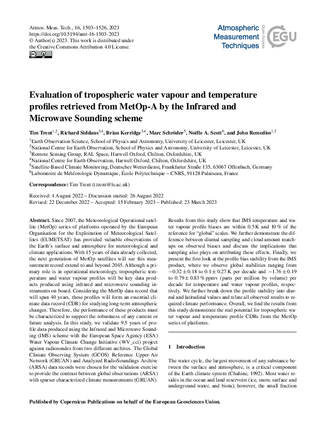Title
Evaluation of tropospheric water vapour and temperature profiles retrieved from MetOp-A by the Infrared and Microwave Sounding scheme
Authors
Trent, T., Siddans, R., Kerridge, B., Schröder, M., Scott, N. A., and Remedios, J.
Published
by Atmospheric Measurement Techniques (AMT) at 2023-03-23
Abstract
Since 2007, the Meteorological Operational satellite (MetOp) series of platforms operated by the European Organisation for the Exploitation of Meteorological Satellites (EUMETSAT) has provided valuable observations of the Earth's surface and atmosphere for meteorological and climate applications. With 15 years of data already collected, the next generation of MetOp satellites will see this measurement record extend to and beyond 2045. Although a primary role is in operational meteorology, tropospheric temperature and water vapour profiles will be key data products produced using infrared and microwave sounding instruments on board. Considering the MetOp data record that will span 40 years, these profiles will form an essential climate data record (CDR) for studying long-term atmospheric changes. Therefore, the performance of these products must be characterized to support the robustness of any current or future analysis. In this study, we validate 9.5 years of profile data produced using the Infrared and Microwave Sounding (IMS) scheme with the European Space Agency (ESA) Water Vapour Climate Change Initiative (WV_cci) project against radiosondes from two different archives. The Global Climate Observing System (GCOS) Reference Upper-Air Network (GRUAN) and Analyzed RadioSoundings Archive (ARSA) data records were chosen for the validation exercise to provide the contrast between global observations (ARSA) with sparser characterized climate measurements (GRUAN). Results from this study show that IMS temperature and water vapour profile biases are within 0.5 K and 10 % of the reference for “global” scales. We further demonstrate the difference between diurnal sampling and cloud amount match-ups on observed biases and discuss the implications that sampling also plays on attributing these effects. Finally, we present the first look at the profile bias stability from the IMS product, where we observe global stabilities ranging from −0.32 ± 0.18 to 0.1 ± 0.27 K per decade and −1.76 ± 0.19 to 0.79 ± 0.83 % ppmv (parts per million by volume) per decade for temperature and water vapour profiles, respectively. We further break down the profile stability into diurnal and latitudinal values and relate all observed results to required climate performance. Overall, we find the results from this study demonstrate the real potential for tropospheric water vapour and temperature profile CDRs from the MetOp series of platforms.
Citation
Trent, T., Siddans, R., Kerridge, B., Schröder, M., Scott, N. A., and Remedios, J.: Evaluation of tropospheric water vapour and temperature profiles retrieved from MetOp-A by the Infrared and Microwave Sounding scheme, Atmos. Meas. Tech., 16, 1503–1526, https://doi.org/10.5194/amt-16-1503-2023, 2023.
Download
Full article (PDF)
